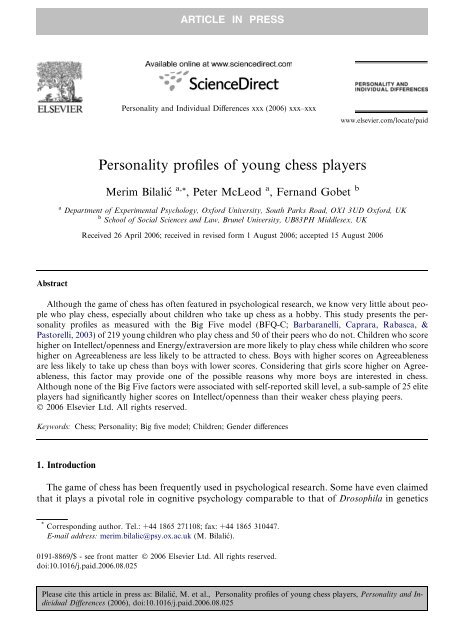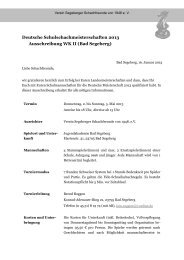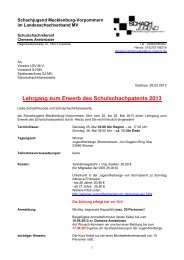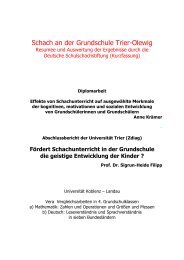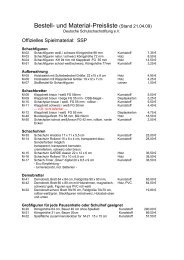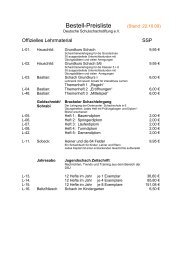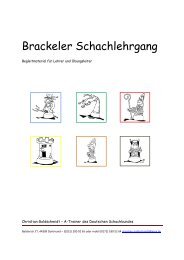Personality profiles of young chess players - Brunel University
Personality profiles of young chess players - Brunel University
Personality profiles of young chess players - Brunel University
Create successful ePaper yourself
Turn your PDF publications into a flip-book with our unique Google optimized e-Paper software.
ARTICLE IN PRESS<strong>Personality</strong> and Individual Differences xxx (2006) xxx–xxxwww.elsevier.com/locate/paid<strong>Personality</strong> <strong>pr<strong>of</strong>iles</strong> <strong>of</strong> <strong>young</strong> <strong>chess</strong> <strong>players</strong>Merim Bilalić a, *, Peter McLeod a , Fernand Gobet ba Department <strong>of</strong> Experimental Psychology, Oxford <strong>University</strong>, South Parks Road, OX1 3UD Oxford, UKb School <strong>of</strong> Social Sciences and Law, <strong>Brunel</strong> <strong>University</strong>, UB83PH Middlesex, UKReceived 26 April 2006; received in revised form 1 August 2006; accepted 15 August 2006AbstractAlthough the game <strong>of</strong> <strong>chess</strong> has <strong>of</strong>ten featured in psychological research, we know very little about peoplewho play <strong>chess</strong>, especially about children who take up <strong>chess</strong> as a hobby. This study presents the personality<strong>pr<strong>of</strong>iles</strong> as measured with the Big Five model (BFQ-C; Barbaranelli, Caprara, Rabasca, &Pastorelli, 2003) <strong>of</strong> 219 <strong>young</strong> children who play <strong>chess</strong> and 50 <strong>of</strong> their peers who do not. Children who scorehigher on Intellect/openness and Energy/extraversion are more likely to play <strong>chess</strong> while children who scorehigher on Agreeableness are less likely to be attracted to <strong>chess</strong>. Boys with higher scores on Agreeablenessare less likely to take up <strong>chess</strong> than boys with lower scores. Considering that girls score higher on Agreeableness,this factor may provide one <strong>of</strong> the possible reasons why more boys are interested in <strong>chess</strong>.Although none <strong>of</strong> the Big Five factors were associated with self-reported skill level, a sub-sample <strong>of</strong> 25 elite<strong>players</strong> had significantly higher scores on Intellect/openness than their weaker <strong>chess</strong> playing peers.Ó 2006 Elsevier Ltd. All rights reserved.Keywords: Chess; <strong>Personality</strong>; Big five model; Children; Gender differences1. IntroductionThe game <strong>of</strong> <strong>chess</strong> has been frequently used in psychological research. Some have even claimedthat it plays a pivotal role in cognitive psychology comparable to that <strong>of</strong> Drosophila in genetics* Corresponding author. Tel.: +44 1865 271108; fax: +44 1865 310447.E-mail address: merim.bilalic@psy.ox.ac.uk (M. Bilalić).0191-8869/$ - see front matter Ó 2006 Elsevier Ltd. All rights reserved.doi:10.1016/j.paid.2006.08.025Please cite this article in press as: Bilalić, M. et al., <strong>Personality</strong> <strong>pr<strong>of</strong>iles</strong> <strong>of</strong> <strong>young</strong> <strong>chess</strong> <strong>players</strong>, <strong>Personality</strong> and IndividualDifferences (2006), doi:10.1016/j.paid.2006.08.025
ARTICLE IN PRESS2 M. Bilalić et al. / <strong>Personality</strong> and Individual Differences xxx (2006) xxx–xxx(Simon & Chase, 1973). Given the prominent status <strong>of</strong> <strong>chess</strong> in psychology, it is surprising that weknow little about (the personalities <strong>of</strong>) the people who perform this activity. Even more surprisingis that we know virtually nothing about (the personality characteristics <strong>of</strong>) children who decide totake up <strong>chess</strong> as a hobby. With this study we try to close this gap by reporting the personality<strong>pr<strong>of</strong>iles</strong>, as measured with the Big Five model, <strong>of</strong> children who play <strong>chess</strong> and those who donot. We also investigate the impact that personality characteristics have on the different interest<strong>of</strong> boys and girls for <strong>chess</strong> as well as on <strong>chess</strong> skill.It is not unusual for a <strong>chess</strong> game to take several hours. In that time the two <strong>players</strong> are alone,fighting each other with their knowledge and will-power. So it is not surprising that Kelly (1985),using the Myers-Briggs Type Indicator, found that <strong>chess</strong> <strong>players</strong> are more introverted and intuitivethan the general population. In addition, stronger <strong>players</strong> also tend to be more intuitive thanweaker ones.Chess is an adversarial game where one has to take into account the opponent’s intentionsand not just focus on one’s own plans. Chess is also a game where just a small mistake canruin the efforts <strong>of</strong> the previous long hours. Hence, <strong>players</strong> should be more suspicious and orderlythan non-<strong>players</strong>. That is exactly what Avni, Kipper, and Fox (1987) demonstrated – <strong>chess</strong><strong>players</strong> scored higher than non-<strong>players</strong> on the measures <strong>of</strong> orderliness and unconventional thinkingin the Minnesota Multiphasic <strong>Personality</strong> Inventory. In addition, it was found that morecompetitive <strong>players</strong>, as measured by the number <strong>of</strong> games played, were more suspicious thannon-<strong>players</strong>.The competitive side <strong>of</strong> <strong>chess</strong> has not escaped the attention <strong>of</strong> researchers. Mazur, Booth, andDabbs (1992) found that testosterone level, usually linked to aggressiveness (see Mazur & Booth,1998), tends to be higher in winners than losers and, with some <strong>players</strong>, to rise just before theirgames. Similarly, Joireman, Fick, and Anderson (2002) showed that sensation seeking discriminatesbetween college students who tried out <strong>chess</strong> and those who never played <strong>chess</strong>, and predictsfrequency <strong>of</strong> playing.A common observation, potentially related to personality factors, is that there are clearly moremen playing <strong>chess</strong> than women. For every woman good enough to be rated by the InternationalChess Federation (FIDE), there are fourteen men (Howard, 2005). While there are several possiblereasons why men play better <strong>chess</strong> than women (see Charness & Gerchak, 1996; Howard,2005), there have been hardly any suggestions as to why more men play <strong>chess</strong>. While it is plausiblethat factors such as intelligence, motivation, and practice influence how good at <strong>chess</strong> people willbecome, it seems reasonable to assume that personality factors may influence people’s preferencesfor hobbies (e.g., Avni et al., 1987).This little evidence we have about people who play <strong>chess</strong> was all obtained in adult samples.Long is the path to being an active adult <strong>chess</strong> player and inevitably some people who learn toplay <strong>chess</strong> will stop at some point. We are thus left to wonder who are the people, or more precisely,children, who start with <strong>chess</strong> in the first place. Why there is such a large discrepancy in thenumbers <strong>of</strong> girls and boys that take up <strong>chess</strong>? It is also not known who are the children who willfind <strong>chess</strong> so engaging that they will spend more time practising than their peers and becomeskilled <strong>chess</strong> <strong>players</strong>. In this study we investigated the personality <strong>pr<strong>of</strong>iles</strong> <strong>of</strong> primary school childrenwho play <strong>chess</strong> and those who do not with the popular Big Five (BF) model (Costa & McCrae,1988). Until recently, self-reported measures <strong>of</strong> the BF model in early and middle childhoodhave been rarely used. The reason was that researchers believed that children at that age are notPlease cite this article in press as: Bilalić, M. et al., <strong>Personality</strong> <strong>pr<strong>of</strong>iles</strong> <strong>of</strong> <strong>young</strong> <strong>chess</strong> <strong>players</strong>, <strong>Personality</strong> and IndividualDifferences (2006), doi:10.1016/j.paid.2006.08.025
ARTICLE IN PRESSM. Bilalić et al. / <strong>Personality</strong> and Individual Differences xxx (2006) xxx–xxx 3able to give reliable self-reports (see Harter, 1998). This view has been recently challenged (e.g.,Shiner, 1998) and meanwhile there are indications that self-reports are not only a valid method<strong>of</strong> measuring personality characteristics in late childhood (e.g., Barbaranelli et al., 2003), but alsothat they may provide the best way for measurement very early in life (Ablow et al., 1999; Marsh,Ellis, & Craven, 2003). For example, Measelle and colleagues (Measelle, John, Ablow, Cowan, &Cowan, 2005) recently followed five year olds for two years and demonstrated that the BF factorswere evident, stable, and replicated throughout this period <strong>of</strong> life.We applied the Big Five Questionnaire for Children (BFQ-C; Barbaranelli et al., 2003), whichmeasures Energy/extraversion, Agreeableness, Conscientiousness, Emotional instability, andIntellect/openness, on primary school children aged eight to eleven. Our main goal was to findout what are the personality characteristics <strong>of</strong> children who decide to take up <strong>chess</strong>, as well asto see whether personality factors can differentiate between strong and weak <strong>players</strong>. We alsowanted to see whether personality factors could shed some light on the issue <strong>of</strong> the large discrepanciesin the participation rates <strong>of</strong> girls and boys. Based on previous results with adults (e.g., Avniet al., 1987; Joireman et al., 2002; Kelly, 1985), we hypothesised that children who play <strong>chess</strong>would score more highly on Conscientiousness but less highly on Energy/extraversion than childrenwho do not play <strong>chess</strong>. Given that <strong>chess</strong> is <strong>of</strong>ten perceived as an intellectual endeavour, wealso hypothesised that Intellect/openness will differentiate between children who take up <strong>chess</strong> andthose who do not. The same personality factors could be expected to differentiate between strongand weak child <strong>chess</strong> <strong>players</strong>.Since women score higher on Emotional instability and Agreeableness (Costa, Terracciano, &McCrae, 2001; Goodwin & Gotlib, 2004; Rubinstein, 2005), two factors previously not shown tobe associated with <strong>chess</strong> skill, it is difficult to have clear-cut predictions as to how these factors arerelated to gender differences in <strong>chess</strong> skill. On the other hand, <strong>chess</strong> has a competitive side where<strong>players</strong> encounter constant conflicts and confrontations (e.g., Mazur et al., 1992), which may beless appealing to children who score more on Agreeableness. Consequently, it is possible thatAgreeableness provides clues about the differences in the number <strong>of</strong> girls and boys who takeup <strong>chess</strong> as a hobby.2. Method2.1. ParticipantsTwo hundred and sixty-nine primary school children (mean age = 10.1 years, SD = 1.2) fromfour schools in Oxfordshire, UK, participated in the study. Two thirds were male; there were 45eight year olds, 61 nine year olds, 70 ten year olds, and 93 eleven year olds. All schools had <strong>chess</strong>club sessions at least once a week and actively participated in regional primary school competitions.So all the children had a chance to take part in <strong>chess</strong> activities.2.2. Instrument and procedureThe BFQ-Q (Barbaranelli et al., 2003) was applied. There are 65 items in the questionnairewhich are supposed to measure the traits <strong>of</strong> Extraversion/energy (e.g., activity, enthusiasm, asser-Please cite this article in press as: Bilalić, M. et al., <strong>Personality</strong> <strong>pr<strong>of</strong>iles</strong> <strong>of</strong> <strong>young</strong> <strong>chess</strong> <strong>players</strong>, <strong>Personality</strong> and IndividualDifferences (2006), doi:10.1016/j.paid.2006.08.025
ARTICLE IN PRESS4 M. Bilalić et al. / <strong>Personality</strong> and Individual Differences xxx (2006) xxx–xxxtiveness and self-confidence), Agreeableness (sensitivity towards others and their needs), Conscientiousness(dependability, orderliness, precision, fulfilment <strong>of</strong> commitments), Emotional instability(feelings <strong>of</strong> anxiety, depression, discontent, and anger), and Intellect/openness (intellect inschool domain, broadness <strong>of</strong> cultural interests, fantasy, creativity, and interest in other people).Each factor is measured with 13 items. Previous research (Barbaranelli et al., 2003; Muris, Meesters,& Diederen, 2005) shows that the BFQ-C has satisfactory internal structure and is a validinstrument for the measurement <strong>of</strong> the big five traits. Before using the BFQ-C, the questionnairewas amended with the help <strong>of</strong> several primary school teachers so that it corresponded to the Englishlanguage used in the UK. The questionnaire was piloted individually on a number <strong>of</strong> primaryschool children in the third and fourth grade (eight and nine years old) in order to ensure thateven the <strong>young</strong>est children in our sample could understand the words used in the questionnaire.Another change to accommodate the <strong>young</strong> children in our sample was the use <strong>of</strong> a three pointLikert type scale (1 = Almost never, 2 = Sometimes, and 3 = Almost always) instead <strong>of</strong> the usual5 point scale. The final score <strong>of</strong> each <strong>of</strong> the five traits is obtained by adding the individual itemscores (the maximum score being 39).In addition to the BFC-Q questionnaire, two questions concerning <strong>chess</strong> playing were asked atthe beginning <strong>of</strong> the questionnaire. The first question asked whether the child knew how to play<strong>chess</strong> (knew the rules) while the second question asked how good at <strong>chess</strong> they were in comparisonwith their peers. The first question could be answered with yes and no while the second employeda 5 point Likert scale – from 1 = very bad to 5 very good. The children who did not play <strong>chess</strong> didnot answer the second question about their skill level and were not included in the analysis performedon that question. The questionnaire was administered in groups during the school hoursby the first author and the teacher <strong>of</strong> the class where the testing took place. Great care was takento ensure that all children understood that it was not a test and that their teachers would not beable to inspect their answers.3. ResultsPrincipal component factor analysis with oblimin rotation, the same method used in previousstudies with the BFQ-C (Barbaranelli et al., 2003; Muris et al., 2005), yielded twenty factors witheigenvalues higher than one (9.25, 3.78, 3.12, 2.46, 2.06, 1.77, 1.63, 1.54, and so on). We extractedthe hypothesized five factors which accounted for 32% <strong>of</strong> the total variance. The factors <strong>of</strong> Agreeableness,Conscientiousness, and Emotional instability had the expected structure where almostall theoretically predefined items unambiguously loaded on one single factor. (The item loadingscan be obtained by writing to the authors.) The same cannot be claimed for the factors <strong>of</strong> Energy/extraversion and Intellect/openness, where only the majority <strong>of</strong> the items loaded on the theoreticalfactors. While it was difficult to categorize the items which loaded on Energy/extraversion andthose which did not, in the case <strong>of</strong> Intellect/openness, it seemed that the openness componentdid not load convincingly. The Intellect component, on the other hand, displayed the expectedpattern <strong>of</strong> results. Consequently, the internal consistency <strong>of</strong> the created five scales as measuredby Cronbach’s alpha was the highest for Agreeableness, Emotional instability, and Conscientiousness(.81, .79, and .78, respectively) and lowest for Energy/extraversion and Intellect/openness(.68 and .72, respectively).Please cite this article in press as: Bilalić, M. et al., <strong>Personality</strong> <strong>pr<strong>of</strong>iles</strong> <strong>of</strong> <strong>young</strong> <strong>chess</strong> <strong>players</strong>, <strong>Personality</strong> and IndividualDifferences (2006), doi:10.1016/j.paid.2006.08.025
ARTICLE IN PRESSM. Bilalić et al. / <strong>Personality</strong> and Individual Differences xxx (2006) xxx–xxx 5It is possible that the <strong>young</strong> children participating in this study have not yet fully developed thetraits <strong>of</strong> Openness and Extraversion. This possibility seems to gain credibility in the light <strong>of</strong> theresults <strong>of</strong> Measelle et al. (2005) who found that the factors <strong>of</strong> Extraversion and Intellect, the sameunclear factors in our study, were not as internally consistent in children between 5 and 7 years oldas they were in a sample <strong>of</strong> college students. In contrast, Agreeableness, Conscientiousness, andEmotional instability were as internally consistent in children as they were in students. However,even when we dropped the two <strong>young</strong>est groups (eight and nine year olds) from the factor analysis,the results remained basically the same, which implies that the problems may lie in the waythe items were phrased.Another plausible reason may be the restriction <strong>of</strong> the answer range (from 1–5 to 1–3) andslight alterations <strong>of</strong> the items to adjust them to the participants’ culture. It is also possible thatthe instrument itself captured these two traits unsatisfactorily given that previous studies by Muriset al. (2005), and partly Barbaranelli et al. (2003), indicated similar problems. The BFQ-C seemsto be a relatively valid and reliable instrument for the measurement <strong>of</strong> the BF model but may needsome additional work on the factors <strong>of</strong> Energy/extraversion and Intellect/openness.Descriptive statistics and inter-correlations for all variables featured in the study can be seen inTable 1. The last two columns in Table 1 show the scores <strong>of</strong> children who can play <strong>chess</strong> (<strong>players</strong>)and those who cannot (non-<strong>players</strong>). Chess <strong>players</strong> were predominantly boys, significantly olderthan non-<strong>players</strong>, had significantly higher scores on Energy/extraversion and Intellect/openness,and significantly lower scores on Agreeableness than non-<strong>players</strong>.We performed a logistic regression to investigate the personality characteristics <strong>of</strong> children whoplay <strong>chess</strong>. We used all five personality factors together with gender and age as the predictors <strong>of</strong><strong>chess</strong> involvement. Given a number <strong>of</strong> significant inter-correlations (see Table 1), we felt that thisapproach would enable us to see how individual predictors contribute towards discriminating<strong>players</strong> and non-<strong>players</strong> when they act together. The logistic regression confirmed the results obtainedwhen the individual predictors were analysed separately. Children who played <strong>chess</strong> weremore likely to be boys (B = .77, Wald (the test for the significance <strong>of</strong> the logistic regression coefficientobtained squaring the ratio <strong>of</strong> the coefficient and its standard error) = 4.2, p < .05), wereolder (B = .38, Wald = 6.5, p < .05), had higher scores on Extraversion (B = .15, Wald = 5.1,p < .05) and Intellect/openness (B = .23, Wald = 12.3, p < .01) but lower scores on Agreeableness(B = .18, Wald = 8.6, p < .01).Table 1 indicates that the proportion <strong>of</strong> the girls who take up <strong>chess</strong> (68%) is smaller than theproportion <strong>of</strong> the boys (88%; v 2 (1, N = 269) = 14.3; p < .01). In addition, Agreeableness was theonly personality factor associated both with gender and with whether or not children played <strong>chess</strong>– boys and <strong>players</strong> scored less on Agreeableness than girls and non-<strong>players</strong>. In order to checkwhether the scores on Agreeableness influenced the choice <strong>of</strong> <strong>chess</strong> as a hobby without regardto gender, we analysed the sub-sample <strong>of</strong> boys. When only boys were included in the analysis,the association between playing <strong>chess</strong> and the score on Agreeableness was still significant(r(182) = .14; p < .05) and there was also a significant difference between the agreeablenessscores <strong>of</strong> boys who play <strong>chess</strong> (M = 29.8, SD = 4.2) and those who do not (M = 31.6, SD =3.6; t(182) = 2.1; p < .05). Hence, the association between Agreeableness and <strong>chess</strong> playing seemsto be a genuine consequence <strong>of</strong> the scores on Agreeableness and not the fact that there aremore girls, who on average score more on Agreeableness, among the children who do not play<strong>chess</strong>.Please cite this article in press as: Bilalić, M. et al., <strong>Personality</strong> <strong>pr<strong>of</strong>iles</strong> <strong>of</strong> <strong>young</strong> <strong>chess</strong> <strong>players</strong>, <strong>Personality</strong> and IndividualDifferences (2006), doi:10.1016/j.paid.2006.08.025
Please cite this article in press as: Bilalić, M. et al., <strong>Personality</strong> <strong>pr<strong>of</strong>iles</strong> <strong>of</strong> <strong>young</strong> <strong>chess</strong> <strong>players</strong>, <strong>Personality</strong> and IndividualDifferences (2006), doi:10.1016/j.paid.2006.08.025Table 1Descriptive statistics, intercorrelations, and <strong>pr<strong>of</strong>iles</strong> <strong>of</strong> children who play <strong>chess</strong> (Players; n = 219) and those who do not (Non-<strong>players</strong>; n = 50)1 2 3 4 5 6 7 8 9 PlayersM (SD)Non-<strong>players</strong>M (SD)(1) Gender (2 = girls) – .01 .03 .25 ** .07 .16 ** .08 .11 .24 ** 26% girls 54% girls(2) Age – .10 .10 .09 .04 .01 .19 ** .19 * 10.2 (1.2) ** 9.6 (1.3)(3) Energy/extraversion – .34 ** .27 ** .20 ** .32 ** .16 * .11 32.3 (3.2) * 31 (3)(4) Agreeableness – .62 ** .29 ** .38 ** .15 * .05 30.5 (4.3) * 32.1 (3.8)(5) Conscientiousness – .34 ** .45 ** .05 .02 28.7 (4.3) 29.2 (4.4)(6) Emotional instability – .17 ** .09 .00 24.5 (4.4) 25.5 (5)(7) Intellect/openness – .19 ** .05 31 (3.3) ** 29.2 (3.9)(8) Playing <strong>chess</strong> (yes/no) – –(9) Chess skill (1–5) –M 1.32 10.10 32.06 30.78 28.81 24.68 30.64 81% yes 2.76SD 0.47 1.20 3.19 4.22 4.28 4.50 3.47 1.53* p < .05.p < .01.6 M. Bilalić et al. / <strong>Personality</strong> and Individual Differences xxx (2006) xxx–xxxARTICLE IN PRESS
ARTICLE IN PRESSM. Bilalić et al. / <strong>Personality</strong> and Individual Differences xxx (2006) xxx–xxx 7Table 2<strong>Personality</strong> <strong>pr<strong>of</strong>iles</strong> <strong>of</strong> the elite sub-sample (n = 25), weaker <strong>players</strong> (n = 194), and non-<strong>players</strong> (n = 50)Elite <strong>players</strong> M (SD) Players M (SD) Non-<strong>players</strong> M (SD)Extraversion 33 (3.1) 32.2 (3.2) 31 (3)Agreeableness 30 (4.3) 30.5 (4.3) 32.1 (3.8)Conscientiousness 29.8 (4.2) 28.6 (4.3) 29.2 (4.4)Instability 24.8 (5.1) 24.5 (4.3) 25.5 (4)Openness * 32.7 (3.2) 30.8 (3.3) 29.2 (3.9)Age * 11.2 (1.2) 10.1 (1.1) 9.6 (1.3)Gender (girls) 0% 29% 54%* p < .01.Gender and the personality factors did not significantly predict perceived <strong>chess</strong> skill when weperformed a regression analysis with all factors included. This is not surprising considering thatthere were no significant correlations between self-reported <strong>chess</strong> skill and personality factors (seeTable 1). Splitting the sample into two groups, comprising the children who reported that they aregood or very good at <strong>chess</strong>, and those who assessed themselves as less able, did not alter the results– none <strong>of</strong> the personality factors discriminated between the two groups.It is possible that self-reported <strong>chess</strong> skill is a biased measure <strong>of</strong> <strong>chess</strong> skill especially consideringthat children had to indicate their skill level in comparison with their peers. We investigatedthis possibility with an elite sub-sample <strong>of</strong> <strong>young</strong> <strong>chess</strong> <strong>players</strong> for which we had an objective estimate<strong>of</strong> skill. The elite sub-sample comprised 25 <strong>players</strong> who were playing regularly in <strong>chess</strong> competitionsand possessed a <strong>chess</strong> rating. A player’s <strong>chess</strong> rating is based purely on their resultsagainst other <strong>players</strong> and is thus an objective measure <strong>of</strong> <strong>chess</strong> skill. Some <strong>of</strong> the children inthe elite sub-sample were selected to represent England in international competitions on numerousoccasions. Their average rating on the British Chess Federation (BCF) scale was 71 (SD = 22). 1When converted to the International FIDE rating, the average rating was 1605 (SD = 108). Thehighest rating was 1835 (more than 1.5 SD above the mean) while the lowest was 1380 (half a SDbelow the average player). Given that the rating <strong>of</strong> the average player (including both adults andchildren) is 1500, our sample was truly exceptional for children.Table 2 presents the personality <strong>pr<strong>of</strong>iles</strong> <strong>of</strong> elite <strong>chess</strong> <strong>players</strong> and <strong>chess</strong> <strong>players</strong> (the <strong>pr<strong>of</strong>iles</strong> <strong>of</strong>non-<strong>chess</strong> <strong>players</strong> are presented for the sake <strong>of</strong> completeness). Elite <strong>chess</strong> <strong>players</strong> tended to bemore emotionally stable, more energetic/extraverted, and more conscientious than all <strong>chess</strong> <strong>players</strong>,although the only significant difference between the two groups was in the extent <strong>of</strong> Intellect/openness. Elite <strong>chess</strong> <strong>players</strong> turned out to be significantly more open to new experiences andmore curious than their less (<strong>chess</strong>) able peers. Elite <strong>chess</strong> <strong>players</strong>, who were exclusively male, werealso older.A logistic regression with the personality factors and age as the predictors indicated that age(B = 1.25, Wald = 17.9, p < .01) and partly Intellect/openness (B = .15, Wald = 3.2, p < .10) were1 There is an international FIDE rating (also called ELO rating) but usually national federations have their own rating(e.g., BCF). The ELO rating has a theoretical mean <strong>of</strong> 1500 and a standard deviation <strong>of</strong> 200. Thus all <strong>players</strong> over 1500can be said to be fairly skilled; masters normally have ratings over 2200, and grandmasters over 2500. The formula forconverting BCF into ELO is: (BCF*5) + 250.Please cite this article in press as: Bilalić, M. et al., <strong>Personality</strong> <strong>pr<strong>of</strong>iles</strong> <strong>of</strong> <strong>young</strong> <strong>chess</strong> <strong>players</strong>, <strong>Personality</strong> and IndividualDifferences (2006), doi:10.1016/j.paid.2006.08.025
ARTICLE IN PRESS8 M. Bilalić et al. / <strong>Personality</strong> and Individual Differences xxx (2006) xxx–xxxsignificant predictors <strong>of</strong> the elite <strong>players</strong>. It should be noted that within this small and elite subsamplenone <strong>of</strong> the personality factors were significantly associated with the rating when age wascontrolled for (the highest correlation was around .30 for Conscientiousness and Agreeableness,while there was no association with Intellect/openness). We also acknowledge that the factors <strong>of</strong>Energy/extraversion and Intellect/openness, which distinguished among elite <strong>players</strong>, <strong>players</strong> andnon-<strong>players</strong>, were the least reliably measured by the BFC-Q. Although this casts a shadow <strong>of</strong>doubt on our findings and conclusions (see Discussion), the pattern <strong>of</strong> the results did not changewhen we included only the reliable items in the final score <strong>of</strong> the Energy/extraversion and Intellect/opennessscales.4. DiscussionThe present study provides, for the first time, a glimpse at the personality <strong>of</strong> children who arelikely to take up <strong>chess</strong>. Children who are less sensitive towards others, more prone to arguing andless to avoiding conflicts (Agreeableness), more energetic (Energy/extraversion) and more open tonew experience (Intellect/openness) are more likely to be attracted to the game <strong>of</strong> <strong>chess</strong>. Given thecompetitive and aggressive side <strong>of</strong> <strong>chess</strong> (e.g., Mazur et al., 1992), the finding that children whoscore lower on Agreeableness are more likely to start <strong>chess</strong> seems reasonable. Chess is a game <strong>of</strong>constant conflicts where each side tries to overwhelm and out hustle the other. This aggressivecomponent may also be one <strong>of</strong> the reasons for the gender differences in the participation rates.The competitive component <strong>of</strong> <strong>chess</strong> may be more appealing to boys than girls, even right atthe start.In our study, for example, boys scored lower on Agreeableness than girls. The same findingabout the gender differences on Agreeableness has been repeatedly obtained in adult samples(e.g., Costa et al., 2001; Goodwin & Gotlib, 2004; Rubinstein, 2005). It is indicative for the role<strong>of</strong> Agreeableness in choosing <strong>chess</strong> that even among the boys, higher agreeableness scores werefound among the children who did not play <strong>chess</strong>. Agreeableness may indeed go a long way inexplaining why more boys than girls take up <strong>chess</strong> as a hobby.Similarly, a predictable result was that children who are prone to intellectual activities, generallycurious, and open to new experiences are likely to find <strong>chess</strong> interesting. Chess has the aura <strong>of</strong>an activity where one has to overcome obstacles with intellectual and not physical power. It is possible,however, that children who are more open to new experience are in general more likely to tryout more different activities than their peers who are less open to new experiences and less intellectual.A slightly more surprising result, at least at first sight, is that the more energetic and extravertedchildren are more likely to play <strong>chess</strong>. This seems to be in contradiction with the findingthat adult <strong>chess</strong> <strong>players</strong> are more introverted than the general population (Avni et al., 1987).Extraverted and energetic children are, however, in general more likely to try out activities thantheir less extraverted peers. Hence it should not be overly surprising to find that more extravertedchildren are more likely to have played <strong>chess</strong>. Finally, this does not mean that they will continueto play <strong>chess</strong> nor that they will invest more time in it than their less extraverted peers.The second set <strong>of</strong> analyses confirms this speculation. Extraversion, together with all other factors,did not predict how well the children in this study perceived their skill level. This pattern <strong>of</strong>results may indicate that personality plays only an important role in <strong>chess</strong> involvement and not inPlease cite this article in press as: Bilalić, M. et al., <strong>Personality</strong> <strong>pr<strong>of</strong>iles</strong> <strong>of</strong> <strong>young</strong> <strong>chess</strong> <strong>players</strong>, <strong>Personality</strong> and IndividualDifferences (2006), doi:10.1016/j.paid.2006.08.025
ARTICLE IN PRESSM. Bilalić et al. / <strong>Personality</strong> and Individual Differences xxx (2006) xxx–xxx 9determining the extent <strong>of</strong> <strong>chess</strong> skill. On the other hand, it is possible that, while personality doesnot predict self-reported skill level, it plays a role when objective measures <strong>of</strong> <strong>chess</strong> skill are applied.The subsequent analysis with the elite sub-sample <strong>of</strong> <strong>young</strong> <strong>chess</strong> <strong>players</strong> points to the latterpossibility. When an objective measure <strong>of</strong> <strong>chess</strong> skill, such as rating, was taken into account, Intellect/opennessdid discriminate between the elite <strong>young</strong> <strong>chess</strong> <strong>players</strong> and weaker <strong>players</strong>. The elitechildren <strong>players</strong> were more curious, had broader intellectual and cultural interests, and were moreaccomplished in school than weaker <strong>players</strong>. Since Intellect/openness is positively associated withintelligence (e.g., Austin, Deary, & Gibson, 1997; Harris, 2004), we could infer that intelligence isan important aspect <strong>of</strong> <strong>chess</strong> skill in <strong>young</strong> children. This fits well with a couple <strong>of</strong> studies whichdemonstrate that children who are good <strong>chess</strong> <strong>players</strong> score higher on intelligence tests than theirpeers who are less accomplished <strong>players</strong> (e.g., Horgan & Morgan, 1990; Frydman & Lynn, 1992).But it would be premature, if not wrong, to extrapolate from these results on children that intelligence,or Intellect/openness, plays an important role in <strong>chess</strong> in general as some authors do (e.g.,Howard, 2005; but see Bilalić & McLeod, 2006). This would be particularly dubious when evenafter a century <strong>of</strong> investigation not a single study with adult <strong>chess</strong> <strong>players</strong> has managed to establisha link between <strong>chess</strong> skill and intelligence (for a review see Gobet, de Voogt, & Retschitzki,2004). Finally, Intellect/openness had little predictive power among the elite sub-sample when theother factors were controlled for.The discussion about intelligence and <strong>chess</strong> leads us to acknowledge the limits <strong>of</strong> our study.While we showed that personality <strong>pr<strong>of</strong>iles</strong> <strong>of</strong> elite <strong>young</strong> <strong>chess</strong> <strong>players</strong>, children who play <strong>chess</strong>and those who do not are indeed different, we did not include other factors <strong>of</strong> interest (e.g., motivation,intelligence) and investigate how they interact. This may not be so crucial for the differentiationbetween children who play and those who do not play <strong>chess</strong>, but it may proveimportant for the differentiation between the elite and less good <strong>young</strong> <strong>players</strong>. It would be incorrect,in our opinion, to claim that Intellect/openness explains well why children became elite <strong>players</strong>at their age. It is possible that other characteristics, such as the amount <strong>of</strong> time spent playing<strong>chess</strong> and motivation, as well as intelligence, have a more direct influence on <strong>chess</strong> skill than personality.Nevertheless, the role <strong>of</strong> personality characteristics in <strong>chess</strong> development seems to be assured.It remains, however, to be seen whether its influence is <strong>of</strong> a direct nature or more <strong>of</strong> anindirect nature – through the influence <strong>of</strong> other factors such as motivation and practice.AcknowledgementsThis research is based on a doctoral dissertation <strong>of</strong> the first author who was supported by Oxford<strong>University</strong> Clarendon and ORS scholarships. We would like to thank Sue Greatbanks, JohnPage, Kim Amos, and Julia Morgan who allowed us to go into their schools, as well as all childrenwho took part in the study.ReferencesAblow, J. C., Measelle, J. R., Kraemer, H. C., Harrington, R., Luby, J., Smider, N., et al. (1999). The MacArthurthree-city outcome study: Evaluating multi-informant measures <strong>of</strong> <strong>young</strong> children’s symptomatology. Journal <strong>of</strong> theAmerican Academy <strong>of</strong> Child and Adolescent Psychiatry, 38, 1580–1590.Please cite this article in press as: Bilalić, M. et al., <strong>Personality</strong> <strong>pr<strong>of</strong>iles</strong> <strong>of</strong> <strong>young</strong> <strong>chess</strong> <strong>players</strong>, <strong>Personality</strong> and IndividualDifferences (2006), doi:10.1016/j.paid.2006.08.025
ARTICLE IN PRESS10 M. Bilalić et al. / <strong>Personality</strong> and Individual Differences xxx (2006) xxx–xxxAustin, E. J., Deary, I. J., & Gibson, G. J. (1997). Relationships between ability and personality: Three hypothesestested. Intelligence, 25, 49–70.Avni, A., Kipper, D. A., & Fox, S. (1987). <strong>Personality</strong> and leisure activities: An illustration with <strong>chess</strong> <strong>players</strong>.<strong>Personality</strong> and Individual Differences, 8, 715–719.Barbaranelli, C., Caprara, G. V., Rabasca, A., & Pastorelli, C. (2003). A questionnaire for measuring the Big Five inlate childhood. <strong>Personality</strong> and Individual Differences, 34, 645–664.Bilalić, M., & McLeod, P. (2006). How intellectual is <strong>chess</strong>? – A reply to Howard. Journal <strong>of</strong> Biosocial Science, 38,419–421.Charness, N., & Gerchak, Y. (1996). Participation rates and maximal performance: A log-linear explanation for groupdifferences, such as Russian and male dominance in <strong>chess</strong>. Psychological Science, 7, 46–51.Costa, P. T., Jr., & McCrae, R. R. (1988). From catalog to classification: Murray’s needs and the five factor model.Journal <strong>of</strong> <strong>Personality</strong> and Social Psychology, 55, 258–265.Costa, P. T., Jr., Terracciano, A., & McCrae, R. R. (2001). Gender differences in personality traits across cultures:Robust and surprising findings. Journal <strong>of</strong> <strong>Personality</strong> and Social Psychology, 81, 322–331.Frydman, M., & Lynn, R. (1992). The general intelligence and spatial abilities <strong>of</strong> gifted <strong>young</strong> Belgian <strong>players</strong>. BritishJournal <strong>of</strong> Psychology, 83, 233–235.Gobet, F., de Voogt, A., & Retschitzki, J. (2004). Moves in mind – The psychology <strong>of</strong> board games. Hove, UK:Psychology Press.Goodwin, R. D., & Gotlib, I. H. (2004). Gender differences in depression: The role <strong>of</strong> personality factors. PsychiatryResearch, 126, 135–142.Harris, J. A. (2004). Measured intelligence, achievement, openness to experience, and creativity. <strong>Personality</strong> andIndividual Differences, 36, 913–929.Harter, S. (1998). The development <strong>of</strong> self-representations. In: W. Damon (Series Ed.) & N. Eisenberg (Vol. Ed.),Handbook <strong>of</strong> child psychology: Vol. 3. Social, emotional, and personality development (5th ed., pp. 553–617). NewYork: Wiley.Horgan, D. E., & Morgan, D. (1990). Chess expertise in children. Applied Cognitive Psychology, 4, 109–128.Howard, R. W. (2005). Are gender differences in high achievement disappearing? A test in one intellectual domain.Journal <strong>of</strong> Biosocial Science, 37, 371–380.Joireman, J. A., Fick, C. S., & Anderson, J. W. (2002). Sensation seeking and involvement in <strong>chess</strong>. <strong>Personality</strong> andIndividual Differences, 32, 509–515.Kelly, E. J. (1985). The personality <strong>of</strong> <strong>chess</strong><strong>players</strong>. Journal <strong>of</strong> <strong>Personality</strong> Assessment, 49, 282–284.Marsh, H. W., Ellis, L. A., & Craven, R. G. (2003). How do preschool children feel about themselves? Unravelingmeasurement and multidimensional self-concept structure. Developmental Psychology, 38, 376–393.Mazur, A., & Booth, A. (1998). Testosterone and dominance in men. Behavioral and Brain Sciences, 21, 353–397.Mazur, A., Booth, A., & Dabbs, J. M. (1992). Testosterone and <strong>chess</strong> competition. Social Psychology Quartely, 55,70–77.Measelle, J. R., John, P. O., Ablow, C. J., Cowan, A. P., & Cowan, P. C. (2005). Can children provide coherent, stable,and valid self-reports on the Big Five dimensions? A longitudinal study from ages 5–7. Journal <strong>of</strong> <strong>Personality</strong> andSocial Psychology, 89, 90–106.Muris, P., Meesters, C., & Diederen, R. (2005). Psychometric properties <strong>of</strong> the Big Five Questionnaire for Children(BFQ-C) in a Dutch sample <strong>of</strong> <strong>young</strong> adolescents. <strong>Personality</strong> and Individual Differences, 38, 1757–1769.Rubinstein, G. (2005). The big five among male and female students <strong>of</strong> different faculties. <strong>Personality</strong> and IndividualDifferences, 38, 1495–1503.Shiner, R. L. (1998). How shall we speak <strong>of</strong> children’s personalities in middle childhood?: A preliminary taxonomy.Psychological Bulletin, 124, 308–332.Simon, H. A., & Chase, W. G. (1973). Skill in <strong>chess</strong>. American Scientist, 61, 393–403.Please cite this article in press as: Bilalić, M. et al., <strong>Personality</strong> <strong>pr<strong>of</strong>iles</strong> <strong>of</strong> <strong>young</strong> <strong>chess</strong> <strong>players</strong>, <strong>Personality</strong> and IndividualDifferences (2006), doi:10.1016/j.paid.2006.08.025


